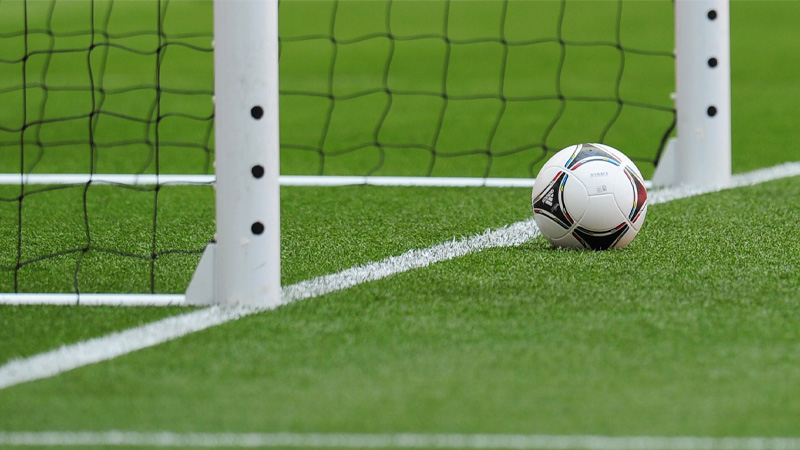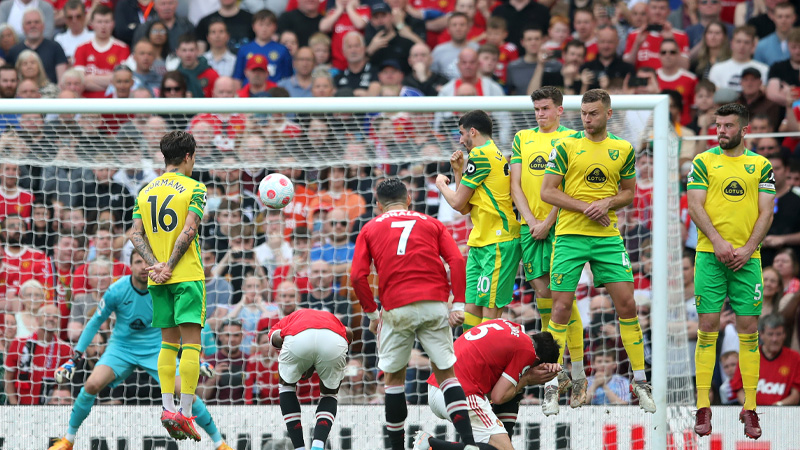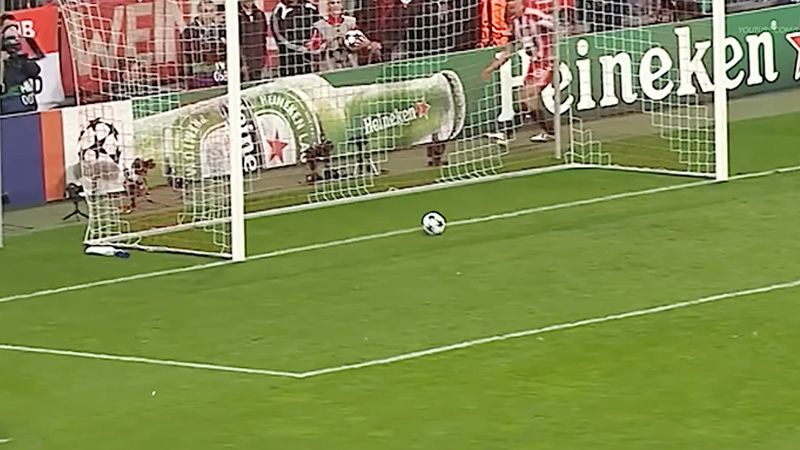In the enthralling world of soccer, where passion and skill collide, the goal line stands as an unyielding symbol of victory and heartbreak. Spanning the width of the field and connecting the goalposts, this invisible threshold holds the power to shape the destiny of teams and players.
It is a line that separates triumph from defeat, heroes from the vanquished, and immortalizes moments that fans cherish for a lifetime.
The goal line’s significance lies not only in its role as the ultimate objective but also in the emotions it stirs – from the euphoria of a last-minute winner to the frustration of a shot that inches wide.
In this article, we embark on a journey to explore what is goal line in soccer and the importance of the goal line in soccer, delving into its impact on the sport’s rich tapestry of history.
What Is Goal Line in Soccer?
In soccer, the goal line is an imaginary line that extends across the width of the field at both ends, connecting the inner edges of the goalposts. The primary purpose of this line is to establish whether a goal has been scored during a match.
For a goal to be awarded, the entire soccer ball must completely cross the goal line between the goalposts and beneath the crossbar, regardless of how briefly the ball enters the net. If any part of the ball remains on or above the line, it is not considered a goal.
Significance of the Goal Line

Source: nytimes
The goal line is undoubtedly one of the most significant elements in soccer. It serves as the ultimate target for attacking teams while acting as a crucial line of defense for the team guarding the goal.
Every team’s main objective is to penetrate the opponent’s defense and propel the ball past the goal line to score a goal, earning precious points and boosting morale.
Goals can change the entire dynamic of a soccer match, often affecting the strategies and tactics employed by both teams. They ignite emotions and adrenaline among players and fans alike, leading to moments of jubilation and heartbreak.
The goal line is the boundary that divides the possible outcomes – victory, draw, or defeat – making it a nerve-wracking and thrilling aspect of the beautiful game.
Soccer Goal Line Rules
The goal line rules in soccer are fundamental to the game and are essential for determining whether a goal has been scored. Here are the key rules related to the goal line in soccer:
Scoring a Goal
A goal is scored when the entire soccer ball crosses completely over the goal line between the goalposts and beneath the crossbar.
It is not necessary for the entire ball to enter the net; as long as any part of the ball crosses the goal line, it counts as a goal.
Offside Rule
The goal line is crucial in implementing the offside rule. A player is considered offside if they are nearer to the opponent’s goal line than both the ball and the second-last defender (usually the last outfield player) at the moment the ball is played to them.
Being in an offside position is not an offense in itself, but a player can be penalized for offside if they are involved in active play, such as interfering with an opponent or gaining an advantage from their offside position when the ball is played to them.
Goal Line Technology (GLT)
In recent years, goal-line technology has been introduced to aid match officials in determining whether a goal has been scored.
GLT uses electronic systems, such as cameras and sensors, to provide real-time and accurate decisions on whether the ball has completely crossed the goal line. This technology helps referees make precise goal decisions and reduces controversies.
Goal Kick
When the ball crosses the goal line, but not into the goal, and was last touched by an attacking player, a goal kick is awarded to the defending team. The goalkeeper takes the goal kick from within the six-yard box.
Corner Kick
Conversely, when the ball crosses the goal line, but not into the goal, and was last touched by a defending player, a corner kick is awarded to the attacking team. The corner kick is taken from the corner arc nearest to where the ball went out of play.
Stoppage Time
The goal line is also relevant when determining stoppage time (added time) at the end of each half. Referees add extra time to compensate for stoppages in play, and this time is typically displayed on the fourth official’s board. Goals can be scored during stoppage time, just like in regular play.
Overall, understanding the goal line rules is crucial for players, coaches, and fans alike, as it greatly influences the outcome of soccer matches and ensures fair play and accurate goal decisions.
What Is Considered a Goal in Soccer?

Source: the18
In soccer, a goal is considered to be scored when the entire soccer ball crosses completely over the goal line between the goalposts and beneath the crossbar. The primary criteria for a goal to be awarded are as follows:
Complete Crossing
For a goal to be valid, the entire ball must cross over the goal line. It is not necessary for the entire ball to enter the net; as long as any part of the ball crosses the line, it is considered a goal.
Between the Goalposts
The ball must pass between the two goalposts, which are the vertical posts at each end of the goal line. If the ball goes over the crossbar or wide of the posts, it is not a goal.
Under the Crossbar
The ball must also pass beneath the crossbar, which is the horizontal bar connecting the goalposts. If the ball hits the crossbar or goes over it without crossing the goal line, it is not considered a goal.
No Foul Play
A goal can only be awarded if there is no infringement of the rules leading up to the goal. If a foul, offside, or other rule violation occurs before the ball crosses the goal line, the goal is disallowed.
Once the ball meets all the criteria mentioned above and crosses the goal line in its entirety, the goal is officially counted, and the team responsible for the goal receives a point.
Scoring a goal is the ultimate objective for the attacking team, and it often brings about moments of celebration and elation for both players and fans.
What Is the Goal Line Technology (GLT)?
Goal Line Technology (GLT) is an advanced technological system used in soccer to assist match officials in determining whether a goal has been scored.
The primary purpose of GLT is to provide accurate and objective decisions regarding the ball crossing the goal line, eliminating any controversies or human errors that may arise during critical moments of a match. Here are the key features and components of GLT:
Camera-Based System
GLT typically employs multiple high-speed cameras installed around the goalposts and crossbar. These cameras continuously track the position of the soccer ball in real-time.
Ball Tracking Software
Advanced ball-tracking software analyzes the camera feeds to precisely determine the ball’s position in three-dimensional space. The software tracks the ball’s movement and trajectory during crucial goal-scoring situations.
Instantaneous Decision-Making
The GLT system processes the data almost instantaneously and can notify match officials within a second if the ball has fully crossed the goal line.
Vibrating Watch for Referees
Referees wear a special vibrating watch that receives signals from the GLT system. When a goal is scored, the watch vibrates to alert the referee that the ball has crossed the goal line.
Benefits of Goal Line Technology
Here’s why the GLT is important in the game:
Accuracy
GLT provides highly accurate and objective decisions regarding goal-scoring situations, reducing the chances of human error or contentious judgments.
Fairness
The use of GLT ensures that deserving goals are counted, and teams are not unfairly deprived of legitimate goals.
Elimination of Controversies
GLT significantly reduces controversies and debates surrounding goal decisions, promoting the integrity of the game.
Universal Application
GLT can be used in various soccer competitions, from professional leagues to international tournaments, ensuring consistent and reliable goal decisions across different levels of play.
Non-Intrusive
The implementation of GLT does not interrupt the flow of the game, as the decision-making process is quick and seamless.
GLT has been widely adopted in major soccer competitions worldwide, including the FIFA World Cup and various domestic leagues. Its success has led to improved accuracy and transparency in goal decisions, enhancing the overall spectator experience and making soccer matches fairer and more exciting for players and fans alike.
FAQs
What is offside in soccer, and how is it determined?
Offside is a fundamental rule in soccer designed to prevent goal-hanging and promote fair play. A player is considered offside if they are in the opposing team’s half, and closer to the goal line than both the ball and the second-last defender (typically the last outfield player).
What are the dimensions of a standard soccer field?
A standard soccer field’s dimensions can vary slightly depending on the competition or governing body. However, the typical dimensions for a full-size soccer field are approximately 100-110 meters (110-120 yards) in length and 64-75 meters (70-80 yards) in width.
How many players are there on a soccer team?
In a standard soccer match, each team consists of 11 players on the field, including one goalkeeper and ten outfield players. Teams can have additional players on the bench who can be substituted during the game, but only a maximum of three substitutions per team are allowed during regulation time.
What is stoppage time in soccer?
Stoppage time, also known as added time or injury time, is the extra time added to the end of each half in a soccer match to compensate for stoppages in play. Referees may add time to account for injuries, substitutions, time-wasting, or any other delays that occurred during the half.
How is a penalty kick awarded in soccer?
A penalty kick is awarded to a team when a defending player commits a foul inside their own penalty area. The attacking team is then given a direct free-kick from the penalty spot, which is located 11 meters (12 yards) away from the goal line.
Only the goalkeeper from the defending team and the player taking the penalty kick are allowed inside the penalty area until the ball is struck.
Bottom Line
That was all about what is goal line in soccer. In the ever-evolving world of soccer, the goal line remains an unwavering symbol of the sport’s essence.
From the dusty pitches of humble beginnings to the grand arenas of global tournaments, this invisible boundary continues to epitomize the thrill and drama that captivate millions.
Beyond being a mere marker, the goal line weaves stories of triumph and resilience, echoing the cheers of jubilant fans and the sighs of the disappointed.
As technology ensures more accurate decisions and controversies are left behind, the goal line still retains its allure – a canvas upon which dreams are painted, and destinies are shaped.
Soccer’s magnetic charm lies not only in the beauty of its play but also in the raw emotion that surges when the ball crosses that sacred line.







